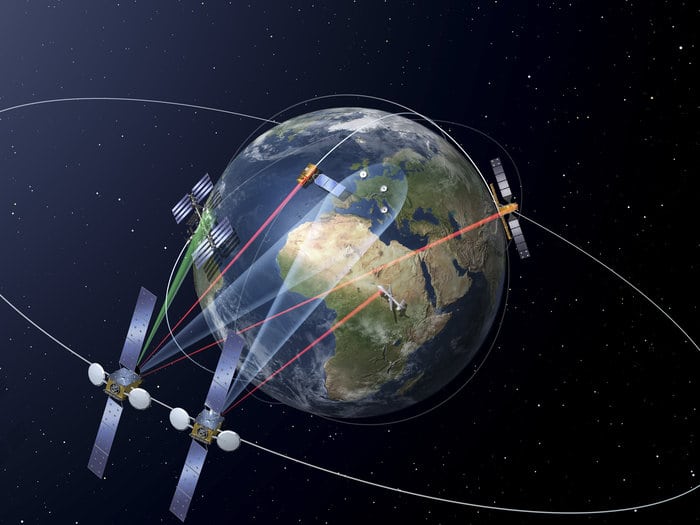Airbus Defence and Space Inaugurates the SpaceDataHighway

An ESA graphic of the European Data Relay System (EDRS), also known as the Space Data Highway. Photo: ESA
[Via Satellite 11-30-2016] Airbus Defence and Space has announced initial service of its SpaceDataHighway. Ultra-broadband laser communications and the geostationary orbit of the relay satellites combine to deliver a secure, near real time data transfer service making strides in data latency.
Thanks to the laser technology developed by Tesat Spacecom, the SpaceDataHighway can transfer high-volume data from Earth observation satellites, airborne platforms, or even from the International Space Station (ISS) at a data rate of 1.8 gbps and can transmit up to 40 terabytes per day. The European Commission’s Earth observation satellites, Copernicus Sentinels, will be the first spacecrafts to benefit from those next generation services.
“The SpaceDataHighway will completely change the way humanitarian crises, maritime safety and the protection of the environment can be managed,” said Evert Dudok, head of the Communications, Intelligence & Security (CIS) business line at Airbus Defence and Space.
The SpaceDataHighway program is a result of a Public-Private Partnership (PPP) between the European Space Agency (ESA) and Airbus Defence and Space. The German national aeronautics and space research center (DLR) is also a key sponsor.
EDRS-A, the first relay satellite for the SpaceDataHighway program was launched on Jan. 30. Positioned at 9 degrees east, this first communication node offers coverage from the American East Coast until India. A second satellite will be launched in 2017, which will extend the coverage, capacity and redundancy of the system.
Airbus Defence and Space is willing to expand the SpaceDataHighway with a third node, EDRS-D, to be positioned over the Asia-Pacific region. This third node will be the next step toward global optical fiber in the sky. EDRS-D will have several laser terminals performing optical bidirectional links in order to serve multiple customers, satellites, and aircraft simultaneously. It will also be able to transfer data to another relay satellite, in order to relay data straight back to the other side of the globe while following security standards.